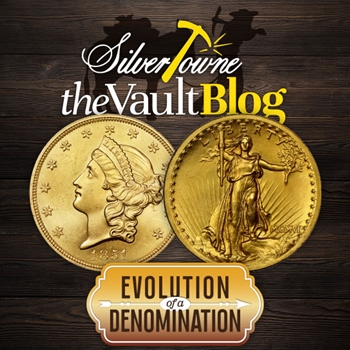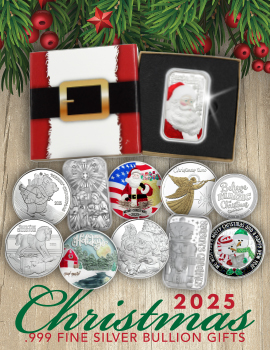
The California Gold Rush was the start of exciting new gold coinage in the United States. The mines were yielding the greatest mass of gold in history, and it was contributing to the development of the American West in an accelerated fashion. While the quarter eagles, half eagles, and eagles were already being produced, the Mint realized quickly that they were going to have to create a larger denomination due to the influx of gold. The smaller coinage was not enough.
Liberty Head (1849-1907)
The amount of gold from the West was showing up in vast quantities. James Iver McKay, a North Carolina Congressman and member of the House Ways and Means Committee, was already preparing legislation authorizing the smallest United States gold coin in the form of the gold dollar. However, as the need to produce a bigger denomination and larger coin became more pressing, McKay switched his focus to include another new gold coin. This ended up being the double eagle, or $20 gold coin. It was eventually authorized and passed by Congress on March 3, 1849.
Amid creating the new gold coins, there was also a conspiracy to oust the Chief Engraver James Barton Longacre. Then Director of the Mint, Robert Patterson, was trying to replace Longacre with medalist Charles Cushing Wright. In addition, the Chief Coiner at the time, Franklin Peale, who was also considered corrupt, feared that Longacre would not go along with his unlawful medal making racket. Both Patterson and Peale would torment Longacre, making him create three separate doubles eagle obverses before the patterns were to be struck with the 1849 date. Despite the constant attempt to oust Longacre, he survived, and the developmental patterns were struck in silver without a date in the early 1850s. The coins would start on January 26th.
The obverse featured a similar Liberty for both the dollar and $10 coin, displaying here portrait with a sharp nose and wearing a pearl bordered diadem with the word LIBERTY inscribed. Longacre’s reverse, based on the Great Seal of the United States, depicts a spread eagle with a shield on its breast and 13 stars in an oval shape and rays above it. UNITED STATES OF AMERICA is also inscribed at the top with the denomination of TWENTY D. featured below.
The Type 1, or No Motto, double eagle coins were struck at Philadelphia only between 1849-1866. They would start being produced additionally at New Orleans between 1850 and 1861, and San Francisco between 1854 and 1866. The one and only 1849 pattern issue resides at the Smithsonian. The San Francisco coins of 1866 were the last of the design is be issued without the motto. However, they were also issued in 1866 with the Type 2 design, or the Motto Above Eagle. The Type 2 $20 gold double eagle was produced from 1866-1876 at Philadelphia, San Francisco, and eventually in Carson City when it opened in 1870. The last change to come in the series before its end was in 1877 when the reverse changed from TWENTY D. to TWENTY DOLLARS.
Saint-Gaudens (1907-1933)
Everyone knows the story by now: President Theodore Roosevelt made it his mission to bring United States coinage to the forefront with an overhaul of designs that would only scream excellence and artistry. Helping him to achieve such a feat was the famous American sculptor, Augustus Saint-Gaudens. Their relationship would propel U.S. coinage in the 20th century, starting with the $20 Saint-Gaudens Double Eagle.
The obverse of the double eagle design features a full-length portrait of Lady Liberty holding a torch in her right hand and an olive branch in her left. Rays of sunlight are behind her with the word LIBERTY inscribed above. Encircling her are 46 stars, once for each state in the Union at the time. Also appearing are the designer's initials, ASG, below the date.
The 1907 Ultra High Relief Pattern, in addition to the 1907 No Motto with which 12,367 coins were struck, features the date in Roman numerals, MCMVII (1907), to the right of Liberty. The reverse depicts an eagle in flight above a sun with its rays extending upwards. UNITED STATES OF AMERICA and TWENTY DOLLARS is also seen above the eagle.
From 1907-1908, there were over 5.2 million coins struck with Arabic numerals. In 1908, coins were also struck in Denver along with Philadelphia. The mint mark appears on the obverse above the date. Also in 1908, the With Motto (IN GOD WE TRUST) variety began production, lasting all the way until the series’ demise in 1933.
Prior to the start of production of the $20 Saint-Gaudens double eagle, the United States Mint started making proof specimens that were struck in Ultra High Relief. These orders came from President Roosevelt himself. The edges were approximately twice as thick as standard coins produced for circulation as the fields appeared concave. They were struck with incredible detail. While the coins were intended to be high relief to present such incredible detail, resistance was met from Chief Engraver Charles E. Barber. He thought it to be impractical. While he was successful in stalling the production of the coins after Saint-Gaudens' passing in August 1907, Roosevelt would eventually step in and overrule Barber.
Earlier coinage strikes were produced with high relief, receiving five blows a piece from the hydraulic press. Some coins had a wire rim, others a flat one, and all of them featured the Roman numeral date. After the Mint was only able to produce 11,250 pieces, they would eventually substitute with new dies that had modified, lower relief. Barber had lost the initial battle but won the war.
Despite the challenges faced with the $20 Saint-Gaudens double eagle, it is still revered as one of the most beautiful coins to have ever been produced. Coins were stuck every year between 1907-1916 until there was a three-year break with production picking back up from 1920-1933. Denver and San Francisco coins were produced in addition to Philadelphia coins.
From 1929 onward, examples were minted as part of the nation’s gold reserves, with few of them released into circulation. Almost all of these coins were seized and melted during the gold recall order in 1933 signed by President Franklin D. Roosevelt, Theodore’s cousin. Double eagles dated 1929-1932 are extremely rare. The Mint produced almost half a million pieces with the 1933 date, but the government upholds that these were never released. This means that it is illegal to own one. Only one example is known today, held in a private collection. Two examples are preserved at the Smithsonian Institution, sent there in 1934.
Even though mintages of the $20 gold coins were reasonable, heavy melting is responsible for the rarities, not low mintages. Survival of the 1927-D, 1920-S, 1921, 1930-S, and 1932 are included as the biggest rarities of the series.
Source: NGC Coin; The Official 2025 Red Book







